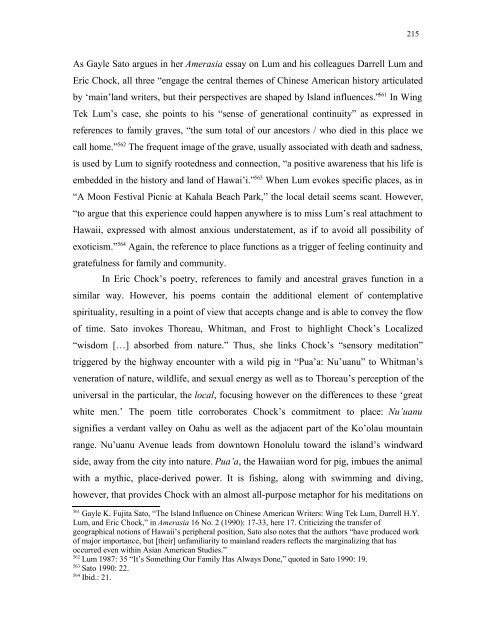A Paradise Lost - KOPS - Universität Konstanz
A Paradise Lost - KOPS - Universität Konstanz
A Paradise Lost - KOPS - Universität Konstanz
You also want an ePaper? Increase the reach of your titles
YUMPU automatically turns print PDFs into web optimized ePapers that Google loves.
As Gayle Sato argues in her Amerasia essay on Lum and his colleagues Darrell Lum and<br />
Eric Chock, all three “engage the central themes of Chinese American history articulated<br />
by ‘main’land writers, but their perspectives are shaped by Island influences.” 561 In Wing<br />
Tek Lum’s case, she points to his “sense of generational continuity” as expressed in<br />
references to family graves, “the sum total of our ancestors / who died in this place we<br />
call home.” 562 The frequent image of the grave, usually associated with death and sadness,<br />
is used by Lum to signify rootedness and connection, “a positive awareness that his life is<br />
embedded in the history and land of Hawai’i.” 563 When Lum evokes specific places, as in<br />
“A Moon Festival Picnic at Kahala Beach Park,” the local detail seems scant. However,<br />
“to argue that this experience could happen anywhere is to miss Lum’s real attachment to<br />
Hawaii, expressed with almost anxious understatement, as if to avoid all possibility of<br />
exoticism.” 564 Again, the reference to place functions as a trigger of feeling continuity and<br />
gratefulness for family and community.<br />
In Eric Chock’s poetry, references to family and ancestral graves function in a<br />
similar way. However, his poems contain the additional element of contemplative<br />
spirituality, resulting in a point of view that accepts change and is able to convey the flow<br />
of time. Sato invokes Thoreau, Whitman, and Frost to highlight Chock’s Localized<br />
“wisdom […] absorbed from nature.” Thus, she links Chock’s “sensory meditation”<br />
triggered by the highway encounter with a wild pig in “Pua’a: Nu’uanu” to Whitman’s<br />
veneration of nature, wildlife, and sexual energy as well as to Thoreau’s perception of the<br />
universal in the particular, the local, focusing however on the differences to these ‘great<br />
white men.’ The poem title corroborates Chock’s commitment to place: Nu’uanu<br />
signifies a verdant valley on Oahu as well as the adjacent part of the Ko’olau mountain<br />
range. Nu’uanu Avenue leads from downtown Honolulu toward the island’s windward<br />
side, away from the city into nature. Pua’a, the Hawaiian word for pig, imbues the animal<br />
with a mythic, place-derived power. It is fishing, along with swimming and diving,<br />
however, that provides Chock with an almost all-purpose metaphor for his meditations on<br />
561 Gayle K. Fujita Sato, “The Island Influence on Chinese American Writers: Wing Tek Lum, Darrell H.Y.<br />
Lum, and Eric Chock,” in Amerasia 16 No. 2 (1990): 17-33, here 17. Criticizing the transfer of<br />
geographical notions of Hawaii’s peripheral position, Sato also notes that the authors “have produced work<br />
of major importance, but [their] unfamiliarity to mainland readers reflects the marginalizing that has<br />
occurred even within Asian American Studies.”<br />
562 Lum 1987: 35 “It’s Something Our Family Has Always Done,” quoted in Sato 1990: 19.<br />
563 Sato 1990: 22.<br />
564 Ibid.: 21.<br />
215

















